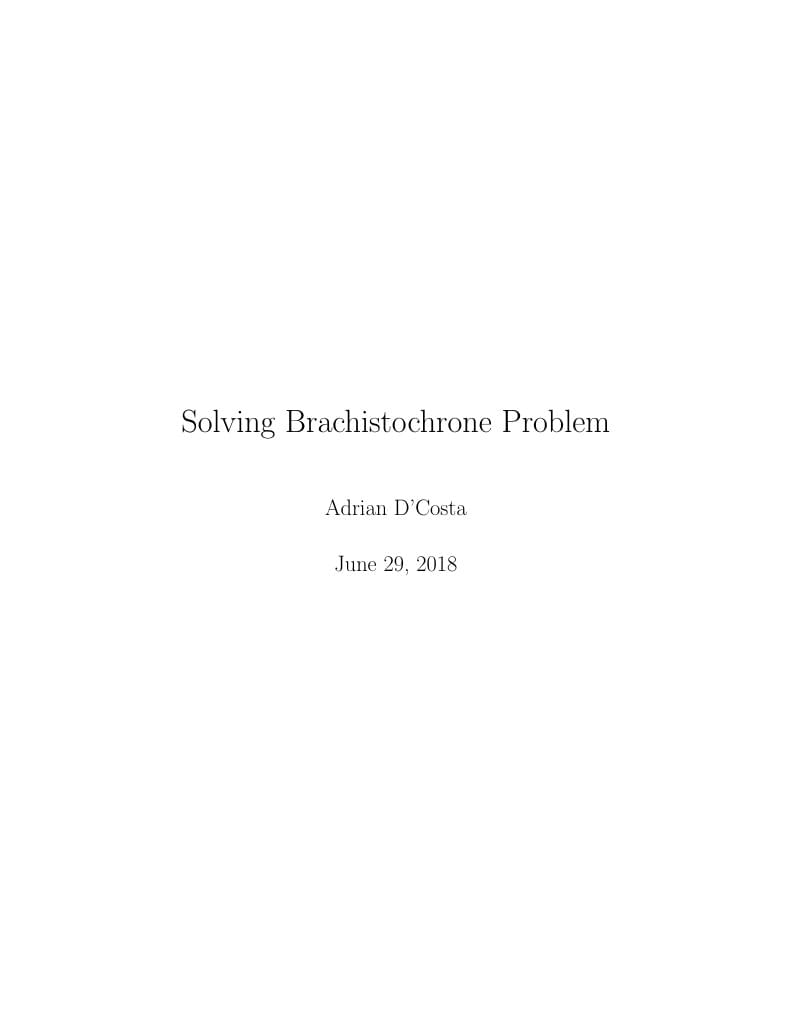
Brachistochrone Problem Solved
Autor:
Adrian D'Costa
Last Updated:
hace 7 años
License:
Creative Commons CC BY 4.0
Resumen:
Solving Brachistochrone Problem

\begin
Discover why over 20 million people worldwide trust Overleaf with their work.
Solving Brachistochrone Problem

\begin
Discover why over 20 million people worldwide trust Overleaf with their work.
\documentclass[14pt]{extreport}
\usepackage[english]{babel}
\usepackage[utf8x]{inputenc}
\usepackage{amsmath}
\usepackage{amssymb}
\usepackage{graphicx}
\usepackage[makeroom]{cancel}
\usepackage{tabularx}
\usepackage{xcolor}
\title{Solving Brachistochrone Problem}
\author{Adrian D'Costa}
\begin{document}
\maketitle
$\displaystyle \int \sqrt{\frac{y}{c-y}}\,\,dy.......\text{(i)}$
\newline
Let:
\begin{align*}&u^{2} = \frac{y}{c-y}......\text{(ii)}\\& u^{2}c - u^{2}y = y\\& y + u^{2}y = u^{2}c\\& y(1 + u^{2}) = u^{2}c\\& \therefore y = \frac{u^{2}c}{1 + u^{2}} \end{align*}
Now:
\begin{align*}\frac{dy}{du} &= \frac{(1 + u^{2})2uc - u^{2}c(2u)}{(1+u^{2})^{2}}\\&= \frac{2uc + 2u^{3}c - 2u^{3}c}{(1+u^{2})^{2}}\\&= \frac{2uc}{(1+u^{2})^{2}}\end{align*}
$\therefore dy = \frac{2uc}{(1+u^{2})^{2}}\,\,du......\text{(iii)}$
\newline
Plugging in $(ii)$ and $(iii)$ into $(i)$ we get:
\newline
$\displaystyle 2 \int \frac{u^{2}c}{(1+u^{2})^{2}}......\text{(iv)}$
\includegraphics[width=\textwidth]{FigureA.jpg}
Again let:
\begin{align*}&u = \cot{(\theta)}\\& du = -\csc^{2}(\theta)\,\,d\theta\\& \text{And } 1 +u^{2} = 1 + \cot^{2}(\theta) \end{align*}
By plugging in all three of these values into $(iv)$ we get:
\newline
\begin{align*}&-2c\int \frac{\csc^{2}(\theta)\cot^{2}(\theta)}{\csc^{4}(\theta)}\,\,d\theta\\&= -2c \int \frac{\cot^{2}(\theta)}{\csc^{2}(\theta)}\,\,d\theta\\&= -c \int 2\cos^{2}(\theta)\,\,d\theta\\&= -c \int (\cos(2\theta) + 1)\,\,d\theta\\&= -c\left(\frac{\sin(2\theta)}{2} + \theta\right) + C\\&= -c\left(\sin(\theta)\cos(\theta) + \theta \right) + C\\&= -c\left(\frac{u}{1 + u^{2}} - \cot^{-1}\left(\sqrt{\frac{y}{c-y}}\right)\right) + C\\&= \left(\sqrt{\frac{y}{c-y}}(y-c) + c \cot^{-1}\left(\sqrt{\frac{y}{c-y}}\right)\right) + C...\text{[Assuming both c and y} > 0 \text{]}\\&\text{[Answer]}\end{align*}
\end{document}